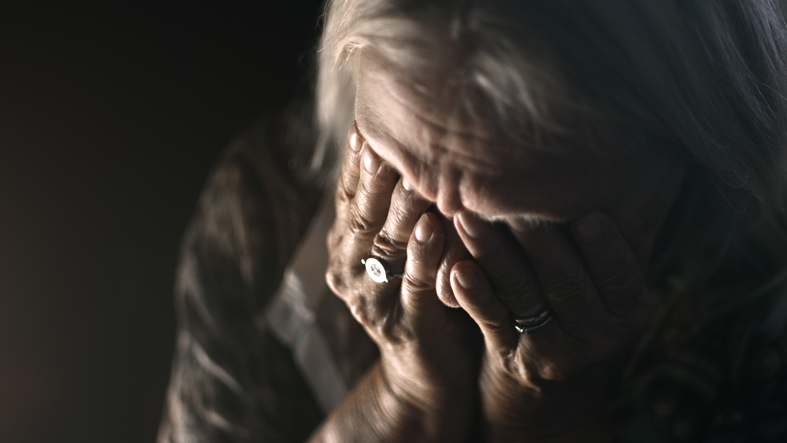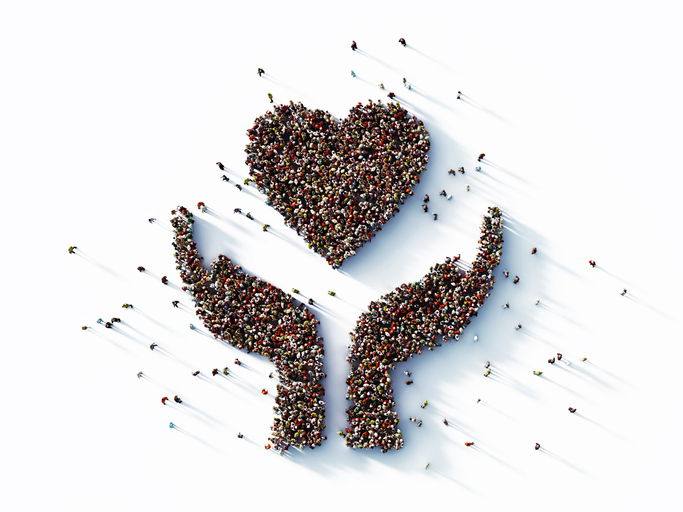“Trauma” is a concept that’s getting increased attention in the world today. Between the COVID-19 pandemic, the war in Ukraine, and the ever-present climate crisis, people are becoming more aware of the adverse and long-term impacts that life events and experiences can have on their mental, emotional, and even physical health. PTSD is no longer associated with military or medical personnel, as people instead recognize that anything from car accidents, toxic relationships, or even bad bosses can severely traumatize people, leaving behind scars they’ll have to put up with for years to come.
One type of trauma in particular that is receiving increased attention in media and pop culture is “generational trauma.” Appearing in blockbuster movies like Everything Everywhere All at Once; hit TV shows like in HBO’s Euphoria and, perhaps more notably, the network’s prestigious Succession; and even cropping up in children’s programming including Disney films like Encanto, Luca, and Turning Red, generational trauma is finally getting the spotlight it has long-since deserved.
“Maybe the poison drips through“ — Kendall Roy, Succession (2023)
Generational trauma, and its many faces (“inter-” “multi-” and “trans-” generational trauma; “historical” “ancestral” or “collective” trauma), is a term used to distinguish trauma that is “passed on” or passed down through the generations from acute, singular, and/or isolated traumatic events. For instance, it’s a way to separate traumatic experiences due to historical oppression from, say, the trauma that’s experienced following a crisis event at work. And that is not to put the latter down: all forms of trauma are equally valid, just as painful, and just as important—but it’s important to make this distinction in order to help people overcome generational trauma due to the differing and complex ways in which it manifests; chief among these including generational trauma’s epigenetic manifestations.
To give an example of what I mean by this, consider how different people react to the climb up Mt. Everest. For the average travelling climber, their journey to the summit is their first experience with a certain elevation—much like an acute traumatic event. Upon reaching these new heights, many of these climbers will deal with altitude sickness or acute mountain sickness due to the lack of oxygen, marked by rapid adaptations to how the body absorbs (e.g., shortness of breath) and distributes (e.g., rapid heart rate) oxygen in an attempt to counteract the deficit. For climbers who ascend and descend gradually, they will experience longer-term changes to their body, including increased hemoglobin in red blood cells or dilated arteries and veins in the brain to maintain oxygen supply and speed up blood flow, all of which could, hypothetically, be passed down to their kin. But the fact remains that these bodily changes are a direct result of personally encountering a catalyst event: the person can pinpoint the source and reasons for their symptoms, can identify when they started, and could even potentially avoid their onset by being informed about mountain climbing ahead of time to take the proper precautions or to avoid the activity altogether.
On the other hand, for those native to the area—including Tibetans, Sherpas, and Nepalis—climbing Mt. Everest is a much different experience—that is, a much more pleasant experience (comparatively, at least), due to a genetic mutation that allows them to live comfortably at higher altitudes that most other people cannot withstand; a mutation that only gradually came about over the course of the 60,000 years in which humans have been said to populate the Tibetan plateau. What this means is that even the direct descendants of these groups who do not themselves live at or even venture up to high altitudes are genetically marked by the experiences of their ancestors with or without their knowledge–potentially making it difficult to discern the source or reasons for certain physical, mental, or behavioral conditions, and equally as challenging to pinpoint solutions for them.
Generational trauma functions much the same way. Not only does it entail the generational “passing on” of trauma through shared stories or myths, family dynamics, and other cultural influences, but it also includes the “passing down” of the traumatic response, including physiological changes like heightened stress levels in the body or brain, emotional dysregulation or behavioral issues, susceptibility to substance use and mental health disorders, and even physical changes (e.g., gastrointestinal, cardiovascular, neurological, musculoskeletal, respiratory, and dermatological). And as one can probably already guess, a person doesn’t have to know about their family or ancestry’s history of trauma to reel from its effects in the present day.
And it’s that truth in particular that makes generational trauma such a difficult challenge to overcome. Not only does it require that people unpack both their conscious and subconscious reactions to the trauma, but also, for many, it requires that they first identify what exactly the trauma is that they need to unpack and overcome. Already challenging on its own, this task is made only more difficult by persisting stigma surrounding mental health and help-seeking; continual experiences of trauma, discrimination, or oppression; as well as limited resources and a lack of culturally relevant education (including psychoeducation).
To combat this, victims and their support team—including mental health professionals, counselors, and clinicians—must first gain a better understanding of what generational trauma is and looks like, how it can impact a person’s psyche and their physical, physiological, social, financial, spiritual, and behavioral health, before determining what treatment methods are right for them.
“We got bad blood in us…Some of these wounds get passed down. Same with what we owe. We should be brown. All that white you see that you got on your skin? We gotta pay for what we done to our own people” — from There There by Tommy Orange (2018)
As the end of the month marks the nation’s annual Truth and Reconciliation Day, Canada is currently sounding the alarms about a growing crisis among its indigenous peoples—particularly, First Nations—as a statement from the chief of Ehattesaht First Nation cites that the “intergenerational effects of residential schools, [displacement from community] and the oppression of the systems that the federal and provincial governments have created” an “unrelenting” drug, alcohol, and mental health crisis—particularly among younger generations.
Cheyenne Stonechild, a descendant of the Muscowpetung First Nation, is one such young person reeling with the effects of decades worth of systematic oppression, displacement, and cultural erosion. In a recent webinar hosted by the Canadian Coalition for the Rights of Children (CCRC) intended to increase morale for a 2020 class-action lawsuit filed against the Canadian government by survivors of the “Millennium Scoop” Stonechild explains how it’s not just her own trauma from being taken by her mother at such a young age that she carries around with her, but that of her mother (a victim of the “Sixties Scoop”) and grandmother (a survivor of the File Hills Indian Residential School); it’s the agony of knowing that her culture and community has been dissolved due to generation after generation of Cree people being apprehended as children and forcibly placed or “adopted” into non-Indigenous families—losing their support system, their language, their agency and spirituality, and their entire way of life.
As such, BIPOC communities are consistently shown to experience trauma at statistically higher rates compared to the general population. Not only do they suffer from the continuing effects of racial discrimination, violence, harassment, hostility, and systematic oppression, but also from the knowledge of what their parents, grandparents, great-grandparents, and even distant ancestors went through.
In addition to that, however, they also deal with the rippling effects of those experiences, including domestic violence and child abuse due to mental health disorders (e.g., bipolar disorder, schizophrenia, borderline personality disorder, depression), substance abuse, anger issues, depersonalization, antisociality, and severe self-esteem issues. This phenomenon, known as race-based traumatic stress injury (RBTSI) is a result of the “unhelpful thoughts and behaviors” that family members develop in response to a traumatic event that oftentimes go unaddressed and unresolved. This can be most readily observed in Black and Indigenous communities who were historically impacted by slavery and residential schools, in which patriarchal indoctrination resulted in an explosion of intimate partner violence due to the erosion of traditional gender roles coupled with the rage, paranoia, and disorientation that most men left the schools or plantations with, which they then passed on to their kin.
That said, in addition to slavery and residential schools, the wide range of traumas covered under the umbrella of “generational trauma” include:
- Wars or national/geopolitical disasters; combat trauma
- Refugee, displacement, and migration-related trauma
- Occupation, apartheid, or genocide-related trauma
- History of incarceration, violence, poverty, and social exclusion
- Natural disasters (e.g. hurricanes, tsunamis, earthquakes, floods, droughts, famines)
- Domestic violence, child abuse or neglect, and other adverse childhood experiences (ACE)
- History of mental health disorders, substance abuse, and suicide
“I see you, Mei Mei. You try to make everyone happy, but you are so hard on yourself. And if I taught you that, I‘m sorry,” — Ming Lee to her daughter, Mei Lee, Turning Red (2022)
The long-term effects of these types of trauma are vast, ranging anywhere from:
To more severe consequences including:
- Impulsivity and high-risk behaviors
- Substance use disorders
- Eating disorders
- Sleep disorders (insomnia, chronic nightmares)
- Gastrointestinal issues (e.g. IBS, IBD)
- Cardiovascular diseases (e.g. hypertension, diabetes, heart disease)
- Cognitive impairment (e.g. memory loss)
- Mental health disorders (e.g. anxiety, depression, and other mood disorders)
- According to findings from the Nurses’ Health Study, depression and chronic depression rates are 1.7 and 2.5 times higher, respectively, among the children of women who experienced severe child abuse, compared to the children of mothers who had not endured any abuse.
- Psychosis
- Derealization or depersonalization
- Complicated grief
- Antisocial behaviors; isolation and withdrawal
- Hypervigilance and lack of trust in others and surroundings
- Self-harm and suicidality
In addition to these, experts caution that there are other warning signs that might indicate the presence of generational trauma in a family, including:
- Fear, unwillingness, or intolerance toward sharing one’s feelings or talking about one’s personal struggles—considering this to be a “weakness”
- Over-protectiveness of children and elderly family members—”even when no danger is present”
- Wariness, intolerance, and hostility toward “outsiders”
- Educational and disciplinary issues among children (e.g. poor grades, dropping out)
“We may not be responsible for the world that created our minds, but we can take responsibility for the mind with which we create our world,” — from In the Realm of Hungry Ghosts: Close Encounters with Addiction by Gabor Maté (2008)
So, with all this (and more) bearing down on people, how can they ever break through the cycle of trauma and the negative chain of events that often comes with it? Well, the good news is, just as trauma can be passed down through the generations, so, too, can resilience; the Mt. Everest anecdote proves as much. Better yet: everyone has the power to cultivate resilience at any point in life. But it takes a team effort: from the individuals hoping to work through their trauma, as well as from their counselors, clinicians, and coaches.
That said, one of the critical first steps towards tackling multigenerational trauma is to really gain a strong sense of awareness as to what exactly is going on externally (e.g., in one’s environment, family, relationships) and internally (e.g., in one’s mind and body; thoughts and behaviors). Self-awareness is a key component to breaking bad habits and cycles of trauma because, well, if you aren’t aware of what needs to be fixed, how can you fix it? Unfortunately, however, mental health stigma remains a major problem in most cultures still to this day, making it hard for people to recognize signs of distress or disorder, identify let alone process their trauma, ask for help, and even admit to themselves that they need help.
It is for this reason that it is so important that people consider talking to a licensed professional at the first sign of trouble: while it might be easier to identify symptoms of trauma, it’s a lot harder to identify the thoughts, instincts, and behaviors that perpetuate it—and even harder to fight back against them. Through guided conversations with trauma-informed mental health professionals, counselors can help clients to:
- “Name the injustice(s)“ or the past and present-day adverse experiences that are undermining their health, wellbeing, growth, and progression;
- Pinpoint areas of pain or distress, or discern how these traumatic events are continuing to impact one’s body, mind, and spirit;
- Identify the “pervasive, underlying” patterns, habits, attitudes, and beliefs that are perpetuating and keeping the individual or their families “stuck,” perpetuating the cycle of trauma;
- Demonstrate compassion for oneself, recognizing and leveraging strengths, let go of shame, guilt, or feelings of self-doubt, and reframing the situation so that it becomes not just manageable, but conquerable;
- Develop new skills, habits, or coping mechanisms that allow them to break down and break through their trauma.
For this to really be successful—individuals and their employers should note—requires the help of culturally sensitive and responsive care professionals. Because generational trauma is so often tied up with one’s culture, ethnicity, or ancestry, there are often a lot of compounding traumas or obstacles that individuals need to work through. Consider, for instance, if a female client is trying to heal from the abuse she experienced as a child—a cycle of parental abuse that goes back many generations—in a patriarchal, misogynistic culture. It would be difficult for her to alleviate the lingering effects of her childhood trauma, like the inability to speak up for herself, set boundaries, or maintain a sense of agency and ownership over her body, when the larger society that she lives in only reinforces these trauma responses. Add in a counselor who is unfamiliar with the client’s cultural norms and practices and who subsequently offers techniques that are unsuitable to the client’s needs, and you have a client who has a rather small chance of recovering from her trauma even with professional help.
Thankfully, culturally responsive therapy is proven to be very effective—especially for individuals suffering from historical or collective trauma. Through the help of a culturally competent counselor, individuals can identify not just personal strengths, but group strengths—pinpointing skills, resources, and social networks in their communities that they can access to support themselves on their healing journey. For those who are members of communities in which psychoeducation is scarce and mental health stigma ubiquitous, culturally responsive care professionals can also provide them with much needed knowledge and information on trauma, its effects, and its solutions, and simultaneously reassure them that their experiences are normal, that they are not alone, that help is out there, and that healing and recovery are possible.
Cultural issues aside, professional, trauma-informed care is also necessary in order for clients to be able to successfully reframe their past and current situations and commit to forming new, healthier habits in response to them. It can be quite hard for people to recognize on their own that they are not their thoughts, that they are not what happened to them, and that they are not to blame—or to really believe those things. Through mindfulness- and body-based therapies, counselors can help clients to separate themselves from their physical or mental traumas, reconnect with their true selves, and determine what their mind or body needs from them in order to heal.
Because, at the end of the day, we already have all the resources we need to heal from our traumas—and it’s up to us to deploy these resources if we are ever to truly heal. As Vani Moodley, Chief Executive at Vani Moodley & Associates, explains about the role of counselors in clients’ journey to recovery: “I’m really a facilitator of a process, I’m not causing the healing. I’m helping you to reflect and to go through a process of forgiveness and self-healing.”
“And it’s all about the individual’s readiness to heal,” she adds. “If they’re not taking their initiative and they’re not ready to heal, then there’s absolutely no way that this process is going to help because it’s not about the person who’s taking them through the process, it’s about themselves and their own readiness to embrace their emotions, their trauma.”
The same rules apply to the process of forgiveness: “[In our work], we also draw on the concept that forgiveness is not about the other person, it’s about the self,” she explains. “We help them to understand that the burden of non-forgiveness is a heavier burden to carry, and that at the end of the day they only have control over their own actions—they don’t have control over what the other person says or does. They have to come to terms with the fact that they can only control what’s within their locus of control and learn how to forgive within these parameters.”
Because equally as paramount to the process of healing is the ability to forgive oneself. Trauma is a tricky thing: it’s something that’s done to someone, but it’s their own mind and their body that perpetuate it: reliving it again, and again, and again—constantly reopening old wounds, convincing the person that the danger is still present, and ultimately getting in the way of their lives by keeping them out of the present and stuck in the past. While it is absolutely not their fault that this happens, Moodley maintains that it’s essential to the healing process that clients recognize that it’s their interpretation of their experience—their own thoughts and somatic responses—that they are caught up in.
“So, let’s question that,” she says, adding that a part of her work revolves around going through a process of questioning in which clients are instructed to pick apart their thoughts, to distance themselves from their traumatic responses, and thus to let go of what’s hurting them. “Oftentimes I will ask my client to think of the thought that disturbs them the most. Then I’ll instruct them to ask themselves, ‘How does that make me feel?’ Once they’ve named their negative feelings, I’ll invite them to ‘drop that thought, just for a split second—just allow it to go.’ and I will ask them again, ‘How does it make you feel?’ Finally, I’ll ask them to give me one good reason why they should hold onto that thought, and once they fail to find a good enough reason, they’re able to let go of the thoughts that they were hanging onto that didn’t allow them to step forward and let their trauma go.”
And that is why consulting with a trauma-informed professional is so important for those from any form of trauma: they need that guidance, or that outside, objective perspective, to help them to see things they didn’t before, or to see things in a different, more conducive way. “There are people who are just not ready to forgive, where forgiveness is just not something on their radar at all,” Moodley admits. “So, what do you do to help them? It all starts with debriefing. We go through the process of having them repeat their experience over and over again. And what happens is that they start having new insights into that experience. They start to see the lessons. They start to see the funny bits. They might even start laughing. So, while they may have started out crying and might have been really upset or depressed, by the time they’ve repeated it to you for the umpteenth time and gained new insights, it’s kind of eased the pressure of the trauma.”
Workplace Options helps individuals balance their work, family, and personal needs to become healthier, happier, and more productive, both personally and professionally. The company’s world-class member support, effectiveness, and wellbeing services provide information, resources, referrals, and consultation on a variety of issues ranging from stress management to clinical services and wellness programs. Contact us to learn more.
Disclaimer: This document is intended for general information only. It does not provide the reader with specific direction, advice, or recommendations. You may wish to contact an appropriate professional for questions concerning your particular situation.



































